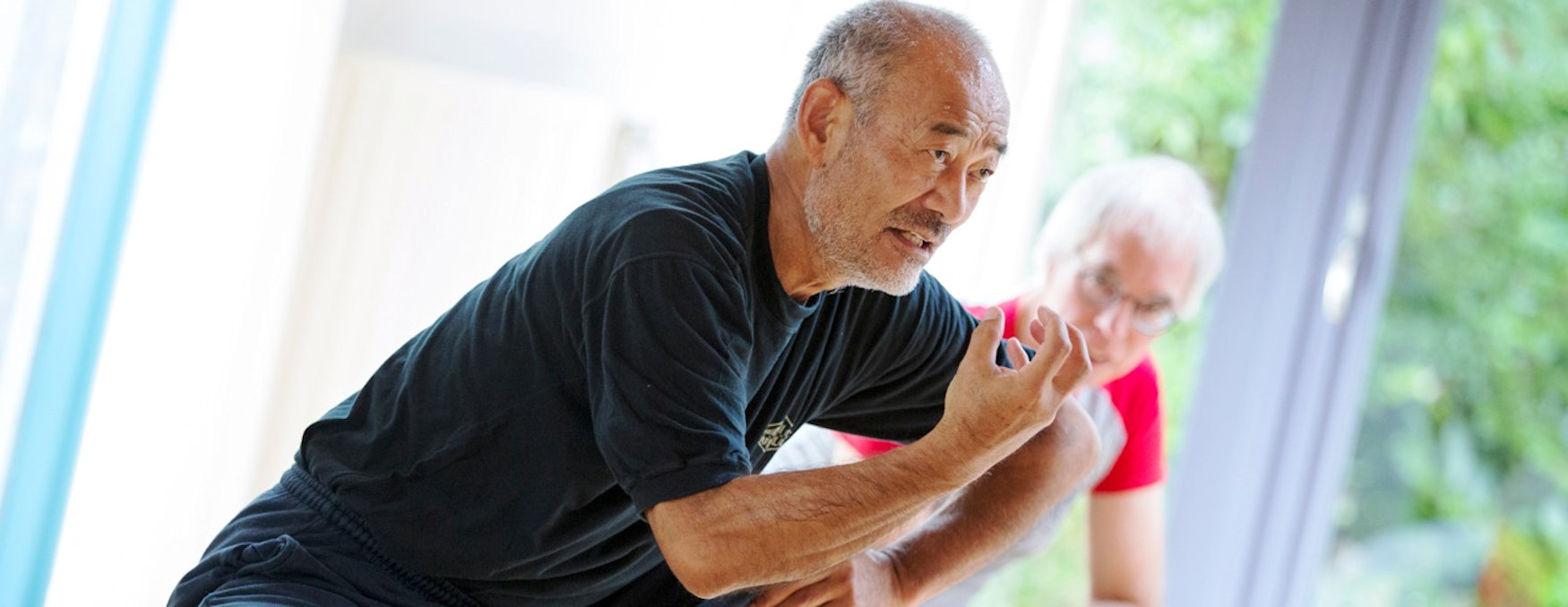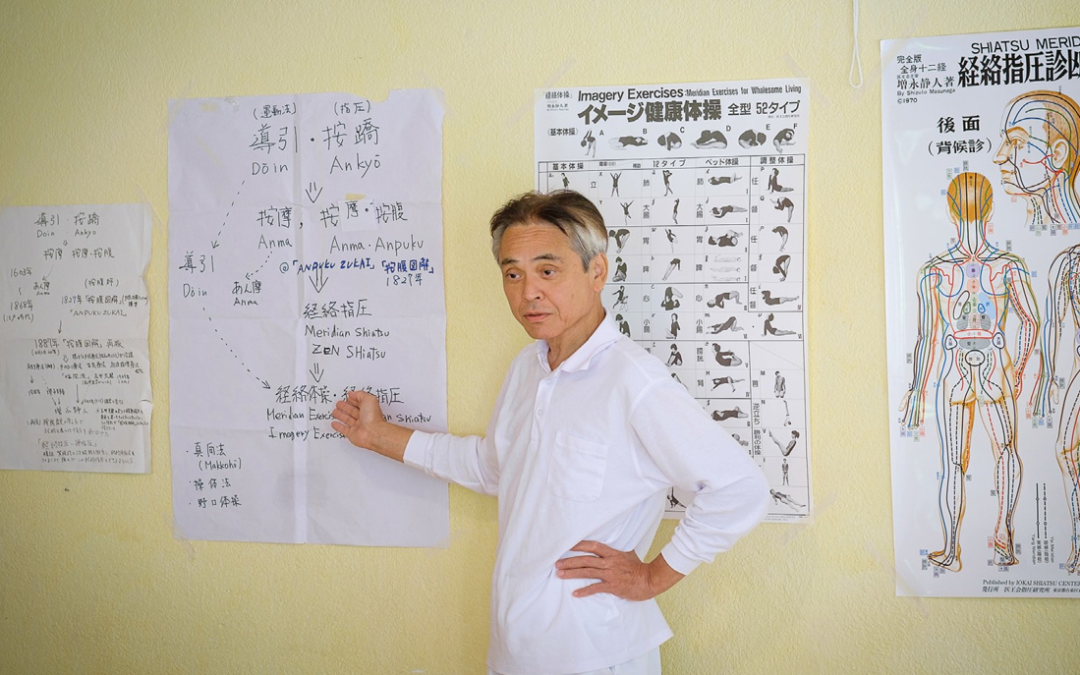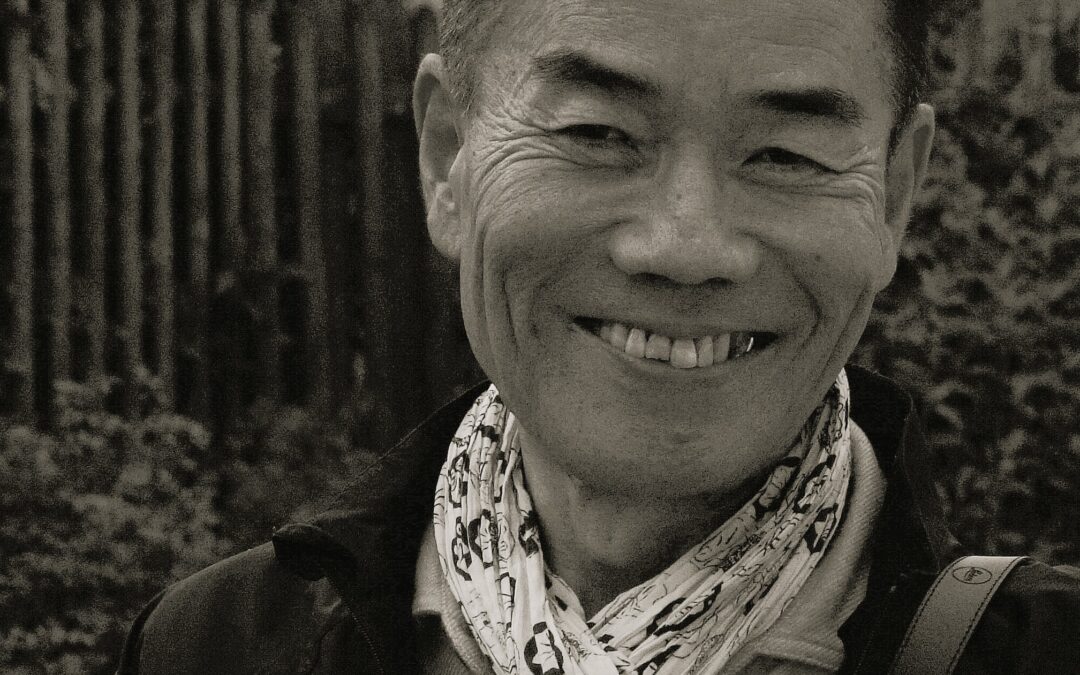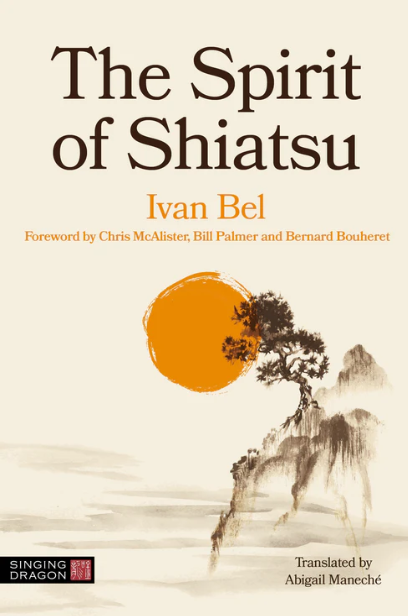One of Iokai’s original staff members, a close assistant to Shizuto Masunaga, has been teaching Iokai Shiatsu in Europe for 40 years: Kazunori Sasaki Sensei who has been sharing what his master transmitted to him, a passion and a deep interest in meridian shiatsu. In this rare interview a great master of shiatsu speaks about his research and his years of sharing the Iokai spirit in Europe.
Ivan BEL: Dear Sasaki Sensei, I’m really happy that you have accepted to do this interview. Looking at the Internet I realized that there is not much information about your path or career to be found. I hope that you would want to speak a bit about yourself.
Kazunori Sasaki: I have been evolving within the European Iokai Shiatsu Academy for many years with close disciples like Thierry Camagie, Christine Breton and other assistants in different European countries. It has been a rich exchange and I’ve been very attached to this traditional way of direct transmission from heart to heart. In Japan we call this I Shin den Shin [I], which means, “Different hearts become the same”. I have enjoyed the privilege to evolve in this way with them, with the teachers, practitioners and with all my students for many years. Nevertheless I’m happy to answer your questions today and I take this opportunity to thank Palle Dyrvall who clarifies my Japanese English and transcribes this interview.
My first question will make you relive your childhood. Where do you come from? Where were you born?
I was born in Yokohama in 1947, in a traditional and ordinary family. At this time Japan wasn’t a modern developed country as it is today. The process of becoming a modern society had just started. Many children were born at this time, there was a baby boom after the war, and I remember that there were many children in each class at school.
When you where a child or teenager did you already have an interest in therapy?
When I went to elementary school there was a boy in my class who had a physical handicap. He had suffered from infantile hemiplegia. I protected him from other bullying children. We became close friends and his father, who was an acupuncturist, took me under his wing.
My mother was also using moxibustion at home and it interested me. This man as well as my mother influenced me a lot.
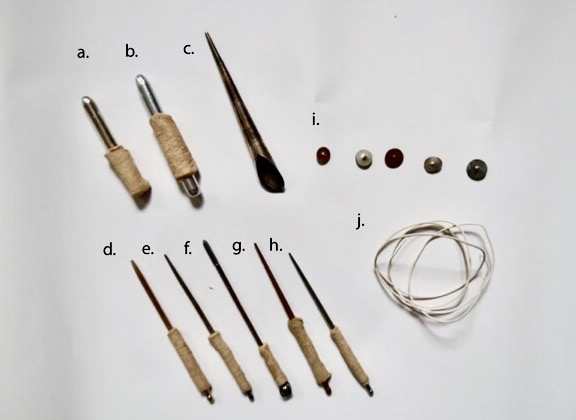
Did you practice martial arts?
In Yokohoma there where many dojo with all kinds of martial arts and generally most kids did martial arts. But since we didn’t have much money I couldn’t attend these classes. So I learned through playing with other kids. Later I did 4 years of military academy and then I studied martial arts very intensely.
I have read that before you practiced Shiatsu you practiced a technique that is not known in the west “Neeshin Ryoho”. Where did you learn this technique? What does it consist of?
A friend of an uncle practiced this technique, and I learned it from him. Alternative medicine wasn’t something rare or special in those days, it was very common. The word itself Neeshin Ryoho, comes from Netsu, which means Heat and Shin, which means Needle. Ryoho simply means treatment method. The tool one used was made up of several dart wheels attached to a handle where each wheel had multiple needle sharp teeth.
It was mainly used for home treatments and was said to specifically help the lymphatic system, to stimulate proper circulation. But it was also a tool for diagnosis. One would heat the roller with electricity and then used it on certain zones of the body. It is common in acupuncture to use moxibusion to heat needles but Neeshin Ryoho is different and technically it’s not so simple. The practitioner has to use wet towels to quickly control the rollers temperature because it’s essential to get it just right. One would then observe pain or absence of pain and also the reactions on the skin. Mostly it was different shades of red but also absence of color was observed. Little by little and step by step I started to use my hands for treatment.
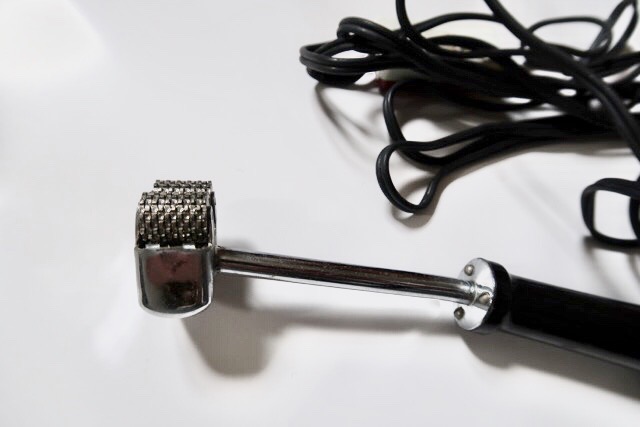
Very interesting. This means that you had already learned about the trajectories of the meridians. What did you feel with the discovery of the meridians?
It was through the interaction with the patients, a process of wanting to understand the patients and their symptoms that I took more notice of the meridians. From there to actually feeling something in contact with the meridians there was a long process. In order to feel the meridians one needs to be free from oneself, one’s expectations, ideas and projections. I didn’t know the subject deeply and I wasn’t free from myself at this time. Only later through years of practice did I discover the feeling of the meridians.
It seems that you were attracted by spirituality quite early on. How did this start?
As a child perhaps one doesn’t use the word spirituality, or think of the practice as spiritual. My mother was a Buddhist so I grew up with this practice all around me. I remember that the powerful atmosphere was very compelling to me. I was sensitive to this as a child and I noticed that there was some invisible power that became visible in the world. I was interested in the truth behind this and also the truth behind other things that I saw. I was interested in electronics for example, not only spirituality.
Did you go to the temple? Did you read some specific books?
Perhaps Buddhism is different from christianity in the sense that the story of Buddha is very accessible to the mind of a child. His story inspired me in its unfolding from childhood to the progressive enlightenment of what is true nature [II]. Perhaps this is different than in the West, for me it didn’t come from the temple or from a book. I was curious about it while growing up in this kind of society and environment.
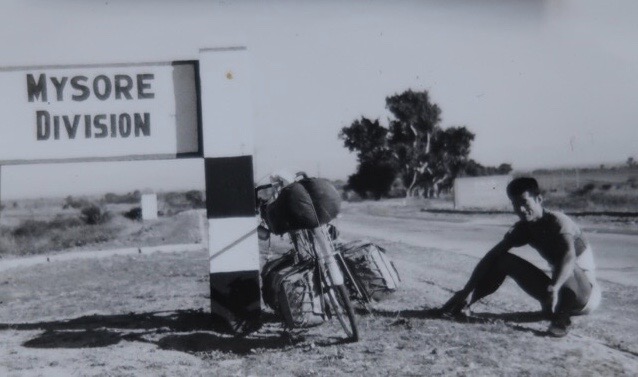
At a certain time your quest for spirituality brought you to India. What where you looking for exactly?
When I was young there wasn’t much TV around, even if it expanded a lot after the war there still wasn’t much around before I was a teenager. So I would listen a lot to the radio and it stimulated my imagination. For example I heard the story Les Misérables and I remember my fascination with Jean Valjean [III]. He was strong and courageous, was generous to the poor and his heart was filled with goodness. These kind of stories interested me a lot as a kid. He was like Robin Hood, he would steal from the rich and give to the poor.
This was probably one reason that brought me to India. I had seen that human society wasn’t fair and honest in India, that there was no real equality between the poor and the rich. And also, and this was the main reason, I wanted to meet Buddha. I’m a Buddhist, and since Buddha came from India, I wanted to go there.
Buddha, who according to the legend, was born as a prince, left his palace and joined the beggars and the poor. I wanted to understand the principle of life according to this story in interaction with simple people of everyday life.
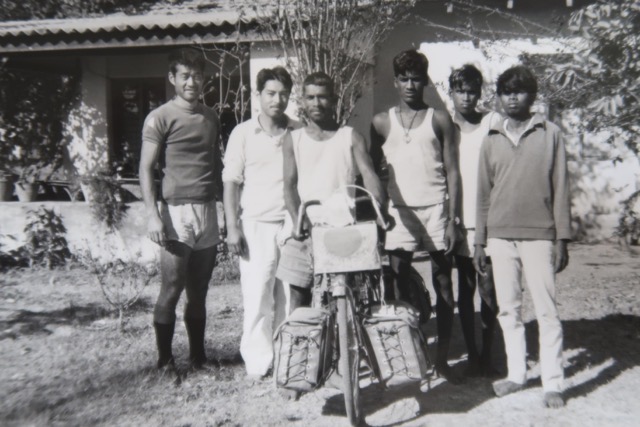
What did you search for exactly?
It was also a search of a free mind, perhaps like a child’s mind, a mind that wasn’t yet formalized by society. I wanted to see what a free mind would be like.
Did you make some important encounters?
One always makes important encounters. In the Orient a tree is a master and nature is the foundation of this culture. You can learn from a tree, a flower and from the wind.
The way one sees life depends on the person but also on the culture that one grew up in.
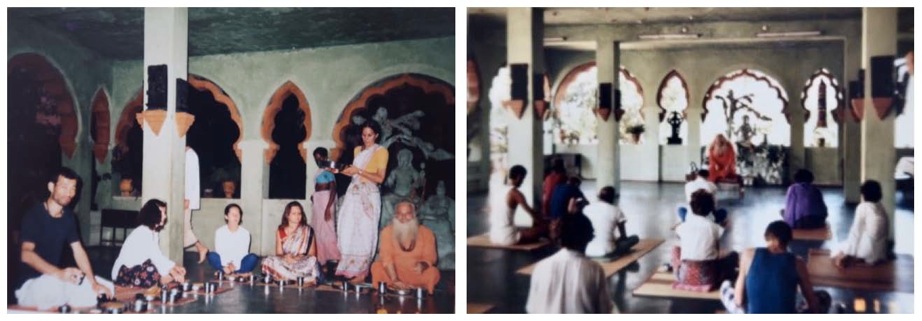
(Photo comments #3 & #4)
In your opinion, is there a link between spirituality and the work with the meridians? Does spirituality help the understanding of Ki?
To me it’s obvious that there is a link between the intimacy with the truth of our being, with the sacred and with the perception of the so called world around us. And I don’t consider Ki and Spirit as being separate. When we act, we act from within and it involves our Ki, witch is linked with the organs and the spirit in the depth of our being. The meridian network is a system of invisible functions that makes the link between the organs and our human activity. If the organism isn’t healthy we can’t perceive the environment correctly and then we don’t know what to do and how to act. So the organs have to be in a good condition for us to act properly together with the environment and all the conditions present at a given moment.
Concerning the understanding of Ki: Ki is global without any specific detail. Even a stone has Ki. But a stone also has spirit, just like a mountain has spirit or a river. A mountain isn’t a river and a river isn’t a mountain but both comes from Ki. But really it’s like the chicken and the egg (laughter) we will never know which came first Ki or spirit.
Finally, when did you discover Shiatsu?
At the time when I was young a very basic approach of Shiatsu existed in daily life. We call it Teate [IV], which is also the origin of Shiatsu. I discovered professional Shiatsu much later but basically, I learned it since early childhood. When my mother wasn’t well she would ask me to do Teate and after she would guide me in how to use my hands. This made me very happy and it was all very intimate and close to me in my life. I would also follow my mother when she went for professional treatments and in this way I got a very basic understanding of the meridians. Later when I studied electronics and learned about its function I put it in relation to the conductive function of the meridians. It seemed like common sense to me. I realized it was different with the transmission of Ki in a human body but I learned more about this spiritual part later.
Did you pass the diploma at the Namikoshi school before following Masunaga? In which year was this?
Yes of course I passed my professional license in Tokyo. In order to become a professional one needs this in Japan, and it’s the same for any professional work. If you want to become a professional painter, for example, you need a license. The same as in order to ride a car you need a State driver’s license. Also Masunaga took his license in the Nippon Shiatsu School (Editor’s Note: also known in English as Japan Shiatsu College or JSC), he wasn’t a doctor so he needed a license as well. I will have to check but I think I got my license in 1975.
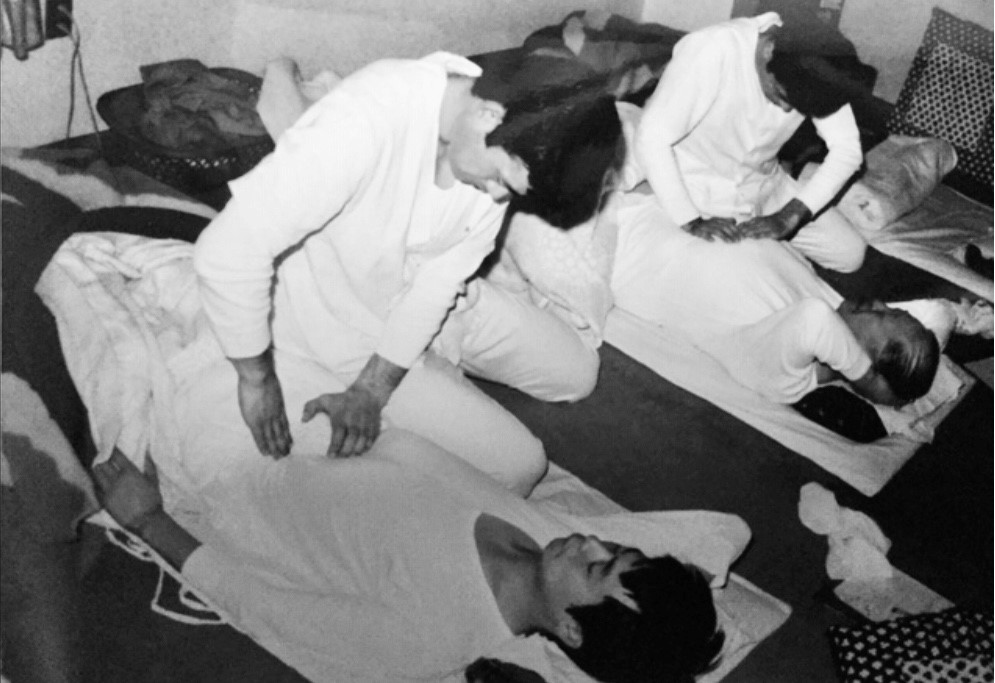
Could you tell us about your first encounter with Masunaga, do you remember this?
I attended the classes at Iokai while I was doing the studies for my professional license. You see, Masunaga Sensei wasn’t my teacher at the Nippon Shiatsu School, he had already left the school at this time, after he had been teaching there for period of 10 years. I remember being very inspired by the way that he was expressing his vision about the meridians in connection with psychology. No other professor spoke of psychology and physical problems together. For someone interested in understanding sickness, it was very interesting. A person is important and interesting to you according to your own interests.
To reflect upon and try to to understand the teachings of Masunaga at this time helped me a lot. My interest in Shiatsu was not only as a physical approach, so meeting Masunaga was like meeting a kindle spirit. Like Masunaga, I was also a Buddhist. So, I was already interested in the invisible, in the non manifested. Still it wasn’t always easy to understand Masunaga as he was referring to Mu and Ku [V]. I remember his lectures from this time as a concentration of psychology, Oriental medicine, linked with Zen Buddhism.
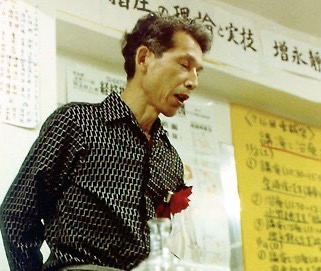
What kind of man was he?
Masunaga Sensei was particular in the sense that he would use a lot of ideas and abstract principles to explain his study and explorations of Shiatsu. He was very theoretical. Privately he was a simple and modest man, not very special. But if somebody is interested in the same thing as you are and also has a lot of experience, he becomes special to you.
How did he teach? Was it difficult to be his student?
In Japan it’s like this: if you come to study with somebody, it’s because you want to and because you respect the teacher. So, one just listens. Also, the students pay so the teacher kindly transmits. He would talk a lot and I would listen. But it was all very interesting.
Masunaga would often discover his interests while teaching and transition from not understanding to spontaneous comprehension in class. Suddenly solutions to previous questions would appear, for example while reading aloud from old articles of his, which was something he would do. Also, there were many interesting people passing by, among them professors and practitioners of Oriental medicine. One clearly felt that Masunaga was actively researching together with his students. This was the spirit at Iokai. It was all very transparent and obvious somehow and I felt much joy and satisfaction in this atmosphere. We were really researching a very deep subject.
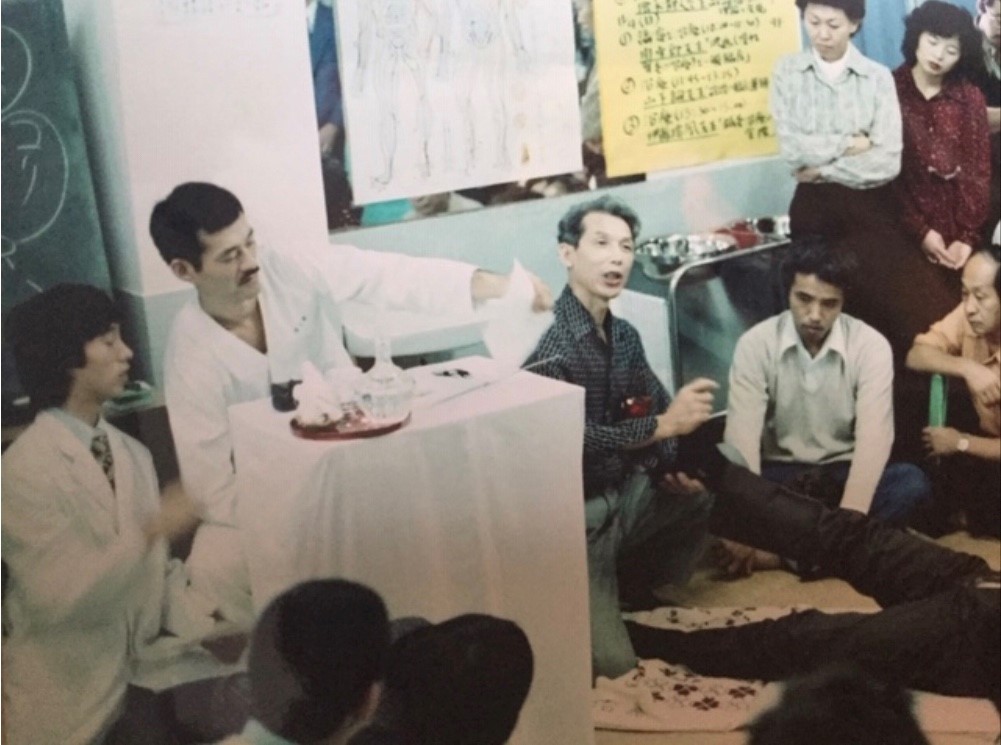
How did the classes go about, were they organized as they are today, or did Masunaga teach according by his intuition?
The classes were organized in the same way as Iokai in Europe: the first module was a basic class for learning the Katas, the second module a meridian class and the third module was the diagnosis class. There was no forth module in Japan, no class of case studies. It was necessary to add this in Europe since we don’t work in the same way with a clinic as Masunaga did [VI]. So I added this to the program in Europe. It’s difficult otherwise for the students to understand the practical applications of Shiatsu together with case studies.
While being several years by the side of Masunaga, you became his assistant. Few people have stayed that long with Masunaga.
I was busy five years full-time at the Iokai clinic. I was busy as part of the staff and since I spoke a bit of English, and since I was an easy person that accepted everything, I stayed long and became close with Masunaga.
Everybody else had another practice, often a room in their homes where they received their own clients. Most of the practitioners came once or twice a week to Iokai. I remember that 40% of the pay went to the clinic and 60% to the practitioners. I was there every day, even on holidays and Sundays, except perhaps once or twice a month.
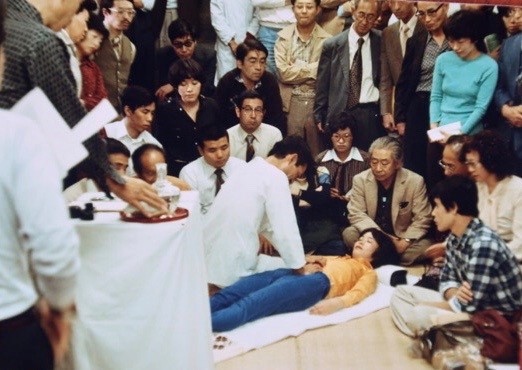
This is really impressive. The only one I know who stayed that long at the Iokai is Akinobu Kishi. Was it like this?
Kishi wasn’t at Iokai for a long time. He practiced Masunaga’s way in the beginning but after he didn’t do Iokai Shiatsu but his own way. He developed his own style. His family was part of a religious sect, Ten Ri Kyo, which means Therapy from Heaven. He grew up in this sect and was influenced by it and other methods like Reiki and other more magical things. He was not very interested in the meridians. For about one year he would come once a week, on Wednesdays, I remember. Masunaga didn’t control much on who came and what method they used, even some used essentially chiropractics or osteopathy in the clinic. But I don’t want to talk about Kishi and Masunaga because I don’t know the truth.
Did you study or work together when he came?
We never studied together but I knew of him and for a while he came to the Ginza clinic once a week, one of the branches of Iokai. There were three clinics at this time: Ginza, which was in an expensive city street, and then also Ueno and Shinjuku [VII]. Perhaps at times he would be at the Iokai and I would be at another clinic, it’s possible. By the way, later Shinjuku closed and only two other clinics were left.
Kishi developed his own style Seiki Soho, but you stayed true to the style of Iokai. Why?
Yes, Kishi developed his own style from a long time back, but I found my truth in the purpose of Iokai, which means King of medicine association. The ancient Sutra that contains I. O. [VIII] corresponds to the ideal that Masunaga had, as well as his attitude towards sickness. When he fell upon it the first time he was inspired and decided to use it as the name for his approach. In the sutra they speak of an elevated being like Buddha, or Jesus. We try to understand what it means to be such a king of medicine at our level. And even though Masunaga was our guide, this purpose was also above him, it was above everything and it is still. And this is why I stayed; I wanted to study this deep subject which is human sickness. I try to understand, I evolve in my skills, I teach and give treatments and I will until the end. Probably this lifetime will not be enough.
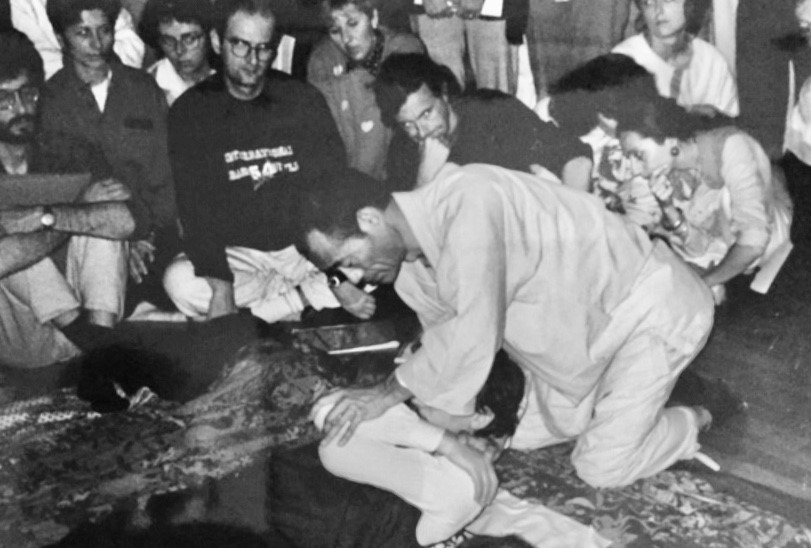
Your words are very inspiring, thank you. Lots of people passed through Iokai during the years that you were there. I’m sure you must have met a number of people that later became well known in the field of Shiatsu in the world. I will quote a few names and perhaps you can tell me your memories about them: Wataru Ohashi, Susuma Kimura, Katsusuke Serizawa, Shizuko Yamamoto, Yuichi Kawada, Izawa Tadashi.
Ohashi visited several times at Iokai, he lived in America and helped to introduce Masunaga over there, as you probably know, he translated the book Zen Shiatsu. He also organized a couple of workshops in America for other teachers like Namikoshi for example. But Ohashi was never part of the Iokai staff.
Kimura was at the Iokai staff for several years, I think he came twice a week to work at the clinic. We were both part of the staff but we didn’t really spend time together. Japanese people are often very busy with their work, when they’re at work. I remember he spoke good English and that he would sometimes privately teach foreigners.
Katsusuke Serizawa was a professor in the university, he had an important position in Oriental medicine and in society in general. He was a Western doctor and was even internationally famous. Because of his position and his knowledge he brought a lot of interest and legitimacy to acupuncture. Though he wasn’t, he could have been a teacher of Masunaga. Also he was not at Iokai.
I met Shizuko Yamamoto in London, but she wasn’t doing Iokai Shiatsu, she was doing barefoot Shiatsu, something that didn’t correspond with me at all.
Yuichi Kawada was never at the Iokai but he studied with Masunaga at the Nippon Shiatsu School. Masunaga was teaching psychology in link with Shiatsu but he could not teach meridian class at the Nippon Shiatsu School because this was the class of Izawa.
Izawa Tadashi had great knowledge of the classical acupuncture meridians and I believe that Masunaga learned many things from his discussions with Izawa. Only when leaving the Nippon Shiatsu School and establishing Iokai could Masunaga teach his way of seeing the meridians as well as his way of making treatment.
Another person at Iokai I remember well is Kono, she followed Masunaga from the beginning of Iokai, she was also responsible for the teaching of the basic class. She wasn’t the most theoretical person; she had a very normal Shiatsu approach, which was good for beginners.

Did your practice make you travel?
I’m a Japanese man and I didn’t do trips just for my pleasure, it was research. I went to China to research and deepen my understanding of Oriental medicine and to learn more about their way of doing diagnosis. I wanted to see if the ancient oriental approach was still alive over there. I also studied a bit of herbal medicine. I studied Tai Chi in Thailand and then further in Taiwan. In India I practiced Yoga. I wanted to experience the Nadi channels and the feeling of the meridians in these practices.
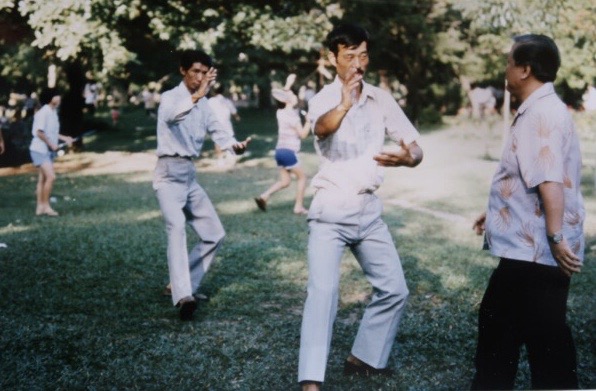
How did you come to stay in France, after all?
Because I met my wife and she was French, would she have been from another country I would probably have ended up staying in another country.
I imagine that being Japanese doing Shiatsu in France in the 80s wasn’t always very easy. How was it during these beginning days and where did you work?
Yes, nobody knew Shiatsu in those days so it was often difficult to introduce it. Where I went for the seminars there would generally be a demand for me to give private Shiatsu sessions. Also, someone who had a Yoga centre in Italy brought me a lot of patients, this is where I gave most of my Shiatsu sessions in those days. Later it followed in France and in other places. This was generally the process of how things developed. Some of the people who had received these private Shiatsu sessions would organize small study groups for further learning of Shiatsu. They would then come to study with me in other places.
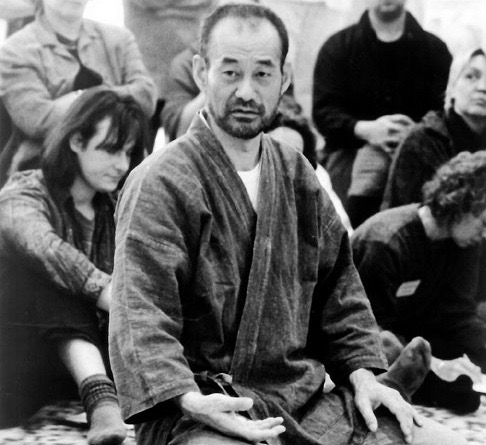
In the beginning you collaborated some time with Yuichi Kawada. After he settled in Belgium, where he went on founding Yoseido Shiatsu. Could you tell us more about this time?
Yuichi Kawada asked me to come to Europe. He had been to the workshop in Paris that Jean Michel Sarraute organized for Masunaga in 1979. Okabe, one of the participants of the workshop had told him I was the assistant of Masunaga. There was also someone else who asked me to come but the invitation of Kawada was one of the reasons I came to Europe. As you said we collaborated for a while but if you want to know about Yuichi Kawada and the development of Yoseido Shiatsu I prefer that you ask Kawada.
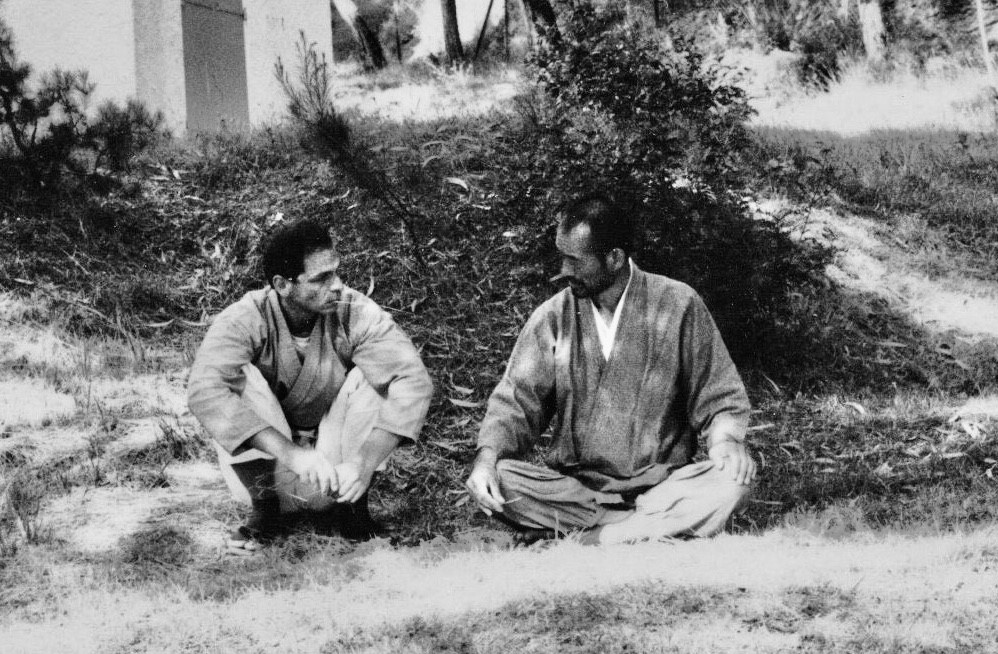
Finally, and with success, you created the European Iokai Shiatsu Association. How did this happen? Which are the countries that are now part of EISA?
In the beginning I must have been going to about 8 European countries. First, I went to Holland and after there was France, Switzerland, Belgium, Luxembourg, Germany, Austria, and Italy. They are now all still members of EISA, all except Italy who is out for the moment but they’ll be back soon, I hope.
Each country has an academy with a slightly different policy, this depends on the laws and the level of recognition that Shiatsu has in each respective country. We have a common point which is the quality of the teaching. The hand is the same in every country and the spirit too. The hand with spirit is characteristic of man. A dog, a pig or a bird also has a kind of five finger hand, but they can’t use it in the same way. We are all deeply interested in the fundamental idea of Iokai. We have a good communication through EISA, every country has a leader who helps this common communication.
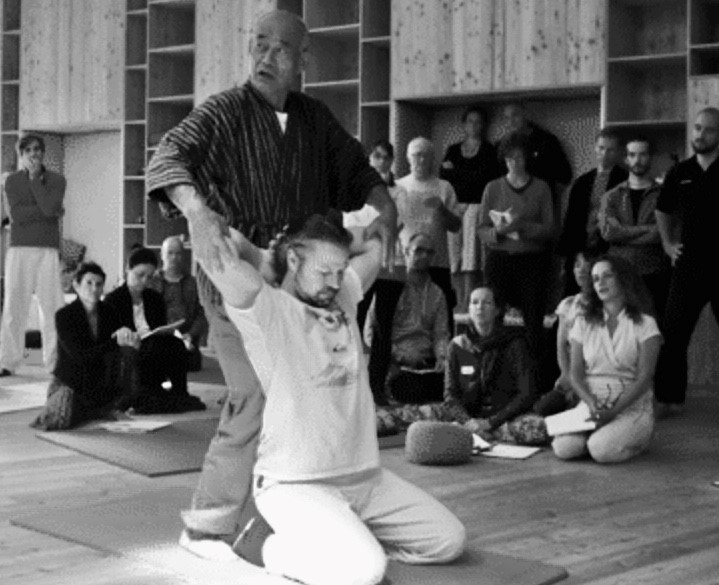
Today you have been teaching thousands of students and you have trained dozens of teachers as well. The only one that I know is Palle Dyrvall in Brussels. Could you give me the names of some important teachers of your organization?
Eloise Sewell founded the Iokai school in Amsterdam more then 30 years ago, Norbert grote Beverborg has now taken over the lead in Holland. Hagen Vogel started Iokai Shiatsu in Germany and after Tilman Gaebler took over. He has been teaching since the end of the 80s. France is a big country and there are many teachers. It was Anne-Marie Delabre who started the first Iokai school there. After, Thierry Camagie in Marseille and Christine Breton in Paris have been the main figures of Iokai France.
In Belgium it was me and Yuichi Kawada who started, Odile Varnat then took over now Palle Dyrvall is the main teacher there. Odile Varnat was also in Luxembourg and now it’s Adela Garçia who is in the lead there. In Austria it was Hugo Somme who started and now Michael Budha has taken over. In Switzerland they are many. Juliette Pillet was there in the beginning and after Nicole Jalil-Demierre has been the main teacher for many years. Now Richard Emery from Sion is the president. We are making a new website for EISA, so soon you will be able to see all the teachers, if you are interested.
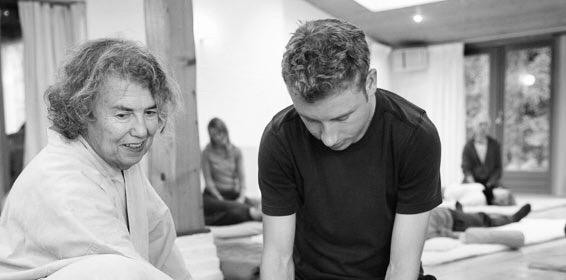
Each year I attend with lots of interest many workshops of all different styles of Shiatsu. What surprises me is that each time I see a course in Iokai Shiatsu around the world it seems different. It seems that there are as many ways to practice Iokai Shiatsu as there are schools. How come it is like this?
Probably your experience is not from a school recognized by EISA. If it had been then probably your question wouldn’t have been the same. I believe that your mistake is mixing up Zen Shiatsu and Iokai Shiatsu. Many schools use the name of Masunaga through the name of Zen Shiatsu, but Masunaga never gave this name to his method [IX]. So yes, it’s a bit of a disturbance to us really because many people make the same mistake as you.
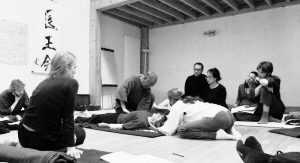
Ah, I understand better now, thanks for making that clear. Could we speak a bit about your Shiatsu? You have said that the meridians are much more then simple channels to transport Ki. Could you explain this to me?
In the ancient Oriental approach, the meridians are described as functions that include both the physical and psychological aspects of man, a body/mind without separation. This is the basic approach of Iokai. I would say that things appear more clearly in consciousness as you spend time with them, given that you are earnest in your wish to understand. I have spent a big part of my life trying to understand people and their complaints through the perspective of the meridians. It has taught me a lot but still I don’t know if I have a clear answer of what the meridians are. The meridians is a very deep subject and aspect of life. It’s difficult for me to say something about that in a few words without giving a lecture.
If I understand well, then the meridians are organic, energetic, psychological and emotional functions. And if so, then a good practitioner should be able to act upon all these aspects of man? Is it like this?
It seems to me that you are dividing things. But what is a human being, is he divided? He who has a life has both a spirit and a body. The one is not the other but we can’t have one without the other. We study that the body has many different kinds of energy, that the spirit does as well and that when they all function harmoniously together life seems light and easy. If a gap appears disrupting this harmony, a stress of some kind, then as a consequence man suffers. Sometimes this can be helped through Shiatsu but sometimes this gap comes from the source, from the DNA, then we can’t help.
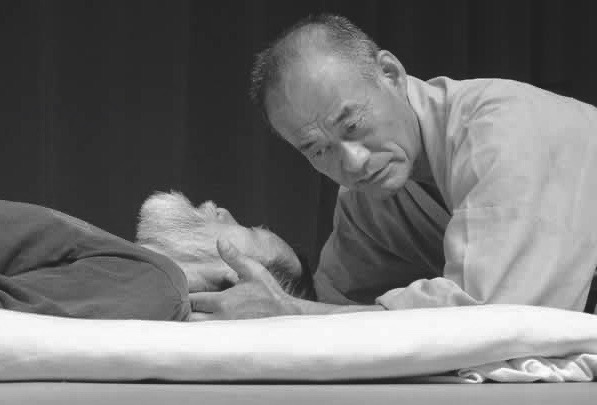
I’m passionated about treating psychological problems through Shiatsu, even though it’s often very difficult. How do you go about these kinds of troubles? Do you simply do basic balancing through Yin/Yang and the Five elements or do you use another method?
The question itself is simple but it’s not easy to give a general answer. Each case is different; the treatment always depends on the person and the current condition he or she is in. As I just said, the body/mind harmonize together in a very delicate way. If you are in a good condition and you are out on a field feeling the wind on your face, it might feel very good. If you are not in a good condition the same wind might be disturbing you both physically and psychologically, you can’t feel peaceful being in the wind. In this way we learn through the ancient Oriental approach about the physical and the psychological. We study many ancient texts at Iokai, we study them from different angles and we try to understand.
I can also add something concerning morality. We have different ideas about what is good and what is bad in different groups and in different societies. And people often suffer because of their beliefs of what is good and what is bad. We are conditioned by our culture, by our upbringing, by rules and laws of society, and it’s also important to learn about these things in order to understand why people suffer. Though one might not learn about this by reading books on psychology or Oriental medicine. We have to observe life.
In Japanese culture one doesn’t speak much about feelings. How does the practitioners do in order to understand that the difficulties a person is facing could be from a psycho-emotional origin?
Traditionally we believe that the mental and the physical have the same source, they are both the expression of Ki, originating from the internal organs. This Ki is depending on and is in interaction with our life activity, with genetics and with the cultural background, as I just explained. Practically, it’s through diagnosis that I try to understand what is the source of the distortion. This is why the study of diagnosis is at the heart of Iokai Shiatsu.
With the experience that you have now with both Japanese and Europeans, what are from your experience the main differences that you encounter when you give Shiatsu treatments?
First and foremost, the treatment always depends on the person but when the culture is different, people are also different. It’s a given and it is also a challenge. It’s true that in the beginning I only gave Shiatsu to Japanese people. When I came to Europe, I remember having to really study the European body and the European culture as well in order to understand people who came to see me. But today I don’t really know how to express this in words.
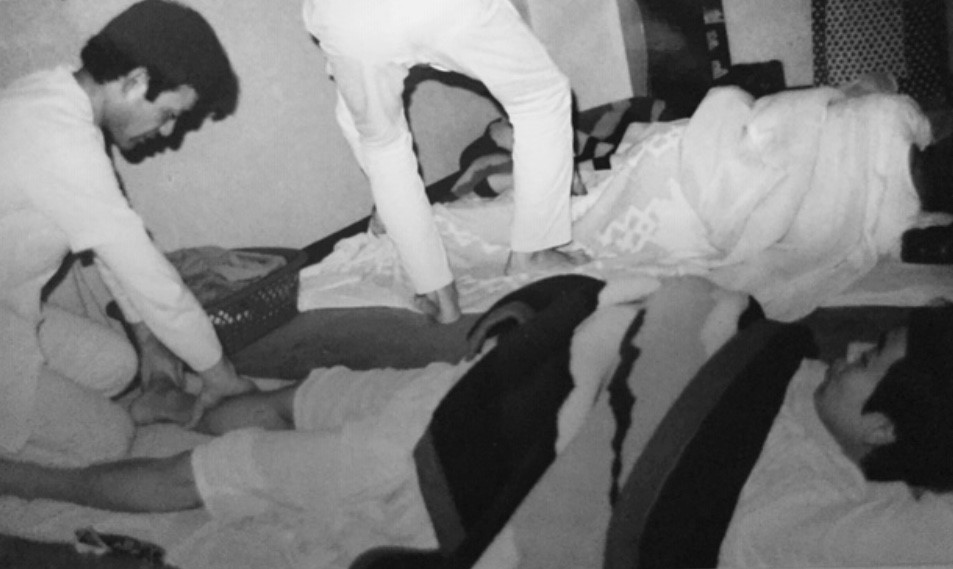
If I count well then, it’s been 50 years that you are doing Shiatsu today. One can speak of an entire life dedicated to this art. Which are the big lessons that Shiatsu has taught you?
I repeat again: Iokai means the King of Medicine Association. And the master or king of medicine knows the true nature of disease. He knows how disease comes to be and he knows how to prevent them. He knows how to deal with illness and he knows how to prevent people from becoming ill. He studies his own disease and the disease of others and he tries to understand. The question what is disease is a big question.
What I have learned is that disease is part of life. And that certain parts of life we like, while other parts we don’t like so much. Most often we don’t like to fall sick, but still sickness often helps us to know about who we are. And it’s the dream of everybody to know their true nature.
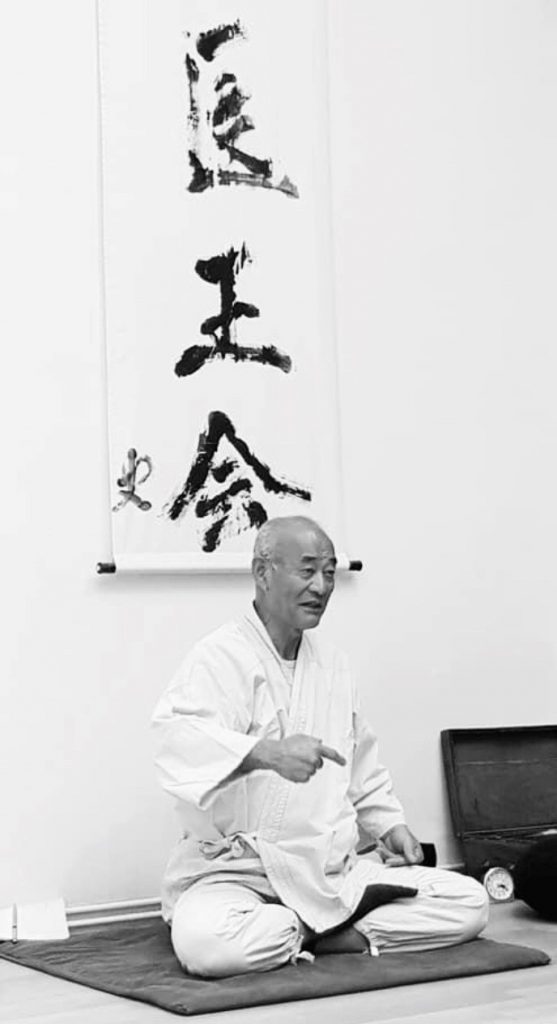
What advice would you give to someone who wants to engage on the path of Shiatsu?
Shiatsu is basically Teate, Te means Hand, and Ate means at the right time and at the right place. It refers to the basic instinct to put the hand on the harmed body. It’s a gentle touch that can help other people, and it helps you too.
When a person in difficulty comes to see you and you can bring back peace through touch, it is very beautiful. And yes, I spent my whole life with this practice but to what degree I have succeeded is a question mark.
I have only two hands but I have been lucky to meet many beautiful and spiritually connected people who have supported one another on this path. It has given us many hands to help many people. I wish that we will continue to develop this art of touch in society and in the world at large. Iokai is not a private enterprise; it’s a common association to investigate human sickness. People with a humble and a spiritual approach are all very welcome.
I thank you very much for having given so much of your precious time. Thank you Sensei.
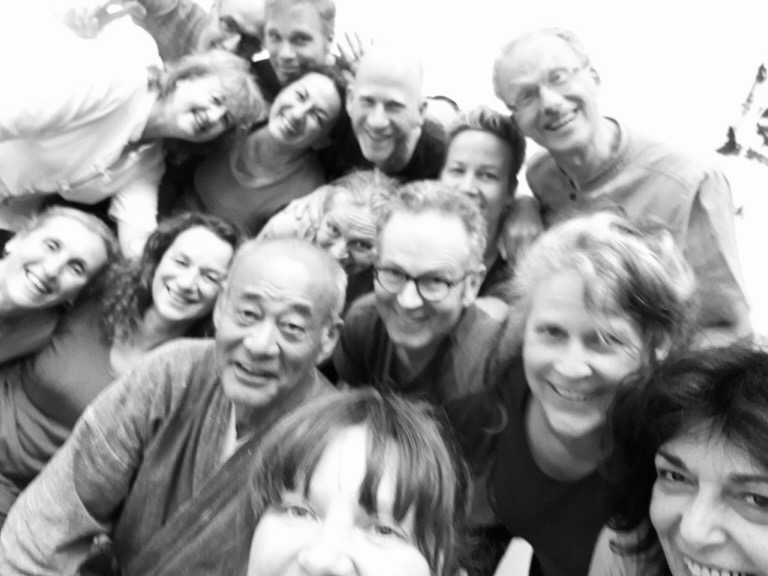
Information:
In September 2020, Sasaki sensei will be in the coming European Shiatsu Congress: https://www.europeanshiatsucongress.eu/trainers/sasaki-sensei/
The EISA association in each country:
- Belgium/Luxembourg : http://www.iokai-shiatsu.be
- France : http://www.iokaishiatsufrance.fr
- Swirtzerland: https://iokai.ch
- Germany: https://www.iokai-shiatsu.de/de/Home.html
- Netherlands: https://www.iokai.nl
- Austria: https://www.iokai-shiatsu.at
Notes:
- [I] « I Shin den shin » is a common expression in all kinds of Japanese arts, it expresses a traditional way of teaching from master to student, from heart to heart.
- [II] In Buddhism, what is called the “true nature of the man” means to leave the world of illusions.
- [III] “Les Misérables” written by Victor Hugo. This should not surprise the reader, because from the Meiji era onwards Japan has been interested in western culture, in the same way that westerners have been interested in Japanese culture.
- [IV] “Teate” is the oldest name given to designate a technique using touch in Japan. One can estimate the use of this name to be about 2,000 years old.
- [V] “Mu and Ku” are two of the main concepts of eastern philosophy, they are fairly close to each other in meaning. They were used by Masunaga in its Iokai Shiatsu. To clearly understand them, read “Shiatsu et médecine orientale”, only in French, Le Courrier du Livre editions, 2017. To learn further see Eiji Mino’s interview that also talks about this subject.
- [VI] The classes where organized differently for the Japanese and the non-Japanese students. The non-Japanese students mostly took the basic Kata class and the meridian class. They rarely stayed more then 3 months, the length of a tourist visa. Most of the Japanese students already had their professional license from the Nippon Shiatsu School, when they came to study at the Iokaï. They mainly followed the meridian and the diagnosis classes.
- [VII] Ginza, Ueno and Shinjuku are names of Tokyo districts.
- [VIII] In the “Ekottara agama”, the forth part of “Agama-Sutra”, the Buddha teaches that the “King” – “O” – of “medecine” – “I” -, knows the true nature of disease. He knows how disease comes to be and he knows how to prevent them. He knows how to deal with illness and how to apply the right treatments so that the illness doesn’t come back.
- [IX] In fact, Ohashi translated Masunaga’s book “Shiatsu” and renamed it “Zen Shiatsu”. Ever since Shiatsu schools around the world have used the name Zen Shiatsu to indicate that they practiced in the style of Masunaga even though they had not studied Iokai Shiatsu. To know more about this subject and Masunaga’s reaction, read Ohashi’s interview.
Photos comments:
- Cover photo: (C) Inge Van Mill
- 1- These handmade needles are crafted on the model of the third of the nine types of acupuncture needles describing with shapes, sizes, and uses in Huangdi’s Internal Classic Ling-shu. The third kind called Tei Shin needles are described as having “a head sharp as a millet grain” and “not to be used to penetrate into the muscles, witch may cause harm to energy”.
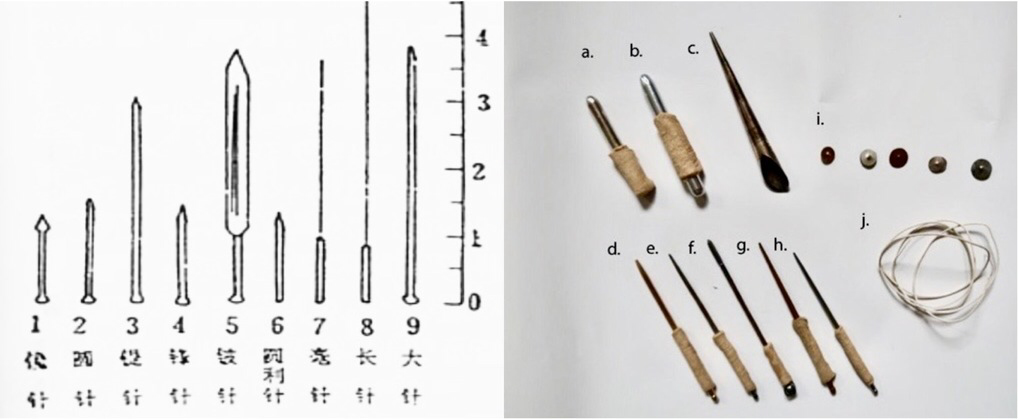
Together with S.Tejima, a friend and college at the Iokai, Kazunori Sasaki Sensei explored the use of these needles according to the descriptions in the Ling Shu. Needles: a) aliminium & b) silver. These two needles has completely rounded heads and are used for tonification when the Kyo is wide and large. c) This silver needle is conically shaped and used for sedation. d) gold needle for tonification. e) silver needle, tonifies less then gold but more then copper f) also a silver needle but a different style for the purpose of sedation. g) & h) copper needles. i) needles to be left in place for a longer time using paper tape. j) Sometimes a wire (mix of silver and copper) is used for connecting but mostly the body of the practitioner makes the bride between two needles. The leather handles are for making the right contact. Using these needles was a way for Sasaki Sensei to deepen his understanding of the meridian and research ways of influencing Ki/Ketsu circulation. Japanese acupuncture and Iokaï Shiatsu use the meridians in a similar way though most shiatsu practitioners in Japan don’t consider the meridians but have a symptomatic approach using pressure points. Using these needles was a process for Sasaki Sensei for deepening his understanding of the meridians. One thing he discovered was how important it is to use ones hands for treating these sensitive channels.
- 2- On his search to find the Buddha Sasaki Sensei felt called to be of help to poor people in India. Here he joined a Japanese friend who managed an agricultural research project to protect the rice fields in south India.
- 3- In 1980, just before traveling to Europe, Sasaki Sensei studied with Dr. Swami Gitananda, a Medical Doctor and Yogi who taught Yoga, ancient philosophical and spiritual concepts in combination with principles of western médecine.
- 4- Swami Gitananda’s yoga class brought good health, well being and helped Sasaki Sensei to a closer understanding of the Nadi channels and the chackras.
- 5- The Ueno clinic was the original Iokai clinic and it’s where Masunaga was present, accept when doing occasional visits to the other two clinics. It was very small with little space in between the futons, sometimes only 30 cm. With the personal belongings of the patients around it easily became messy but the concentration and ambiance was always very good. Sasaki Sensei treasured this time with Masunaga Sensei as he would be very present researching together the subject of the meridians, the secondary branches and diagnosis, that he would generally check before and after every treatment.
- 6- Shizuto Masunaga Sensei bought a new camera on his way to this lecture in 1976/77. He wanted to document this event at the prestigious Shinkyu Acupuncture and Moxibustion College in Tokyo.
- 7- Shizuto Masunaga Sensei is teaching as Kazunori Sasaki is preparing the following presentation with the organiser of the event.
- 5-6 April 25: 1st Balkan Shiatsu Summit in Sarajevo - 31 January 2025
- 19-21 Sept. 2025 – Shiatsu Summit in Vienna: chronic fatigue, burnout & depression - 19 December 2024
- Terésa Hadland interview: Shiatsu at core - 25 November 2024
- Book review: “Another self” by Cindy Engel - 30 September 2024
- 24-26 October 2025: Master Class in Vienna (Austria) – Shiatsu and martial arts - 20 August 2024
- Lembrun Summer Intensive Course – July 6 to 12, 2025: Digestive System Disorders, Advanced Organ Anatomy, and Nutrition - 4 August 2024
